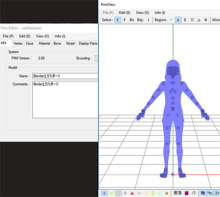
- EXPORT DAZ MODELS INTO SFM HOW TO
- EXPORT DAZ MODELS INTO SFM INSTALL
- EXPORT DAZ MODELS INTO SFM FULL
- EXPORT DAZ MODELS INTO SFM DOWNLOAD
However, most of them are outdated and only work with models compiled for older generations of the Source engine. There are several decompilers for the Source Engine model format.
EXPORT DAZ MODELS INTO SFM DOWNLOAD
Just download it from their Steam Community page, unzip it and run Crowbar.exe. It is a decompiling tool for the Source Engine and a whole bunch more. So for this, we are going to download Crowbar. If the decompiler fails to properly decompile your model, visit the Crowbar Steam community or their Discord server for help. If you have any issues with the decompiler, make sure to read the message output, as it will usually tell you if you did something wrong. Some parts of models may not get decompiled properly, but results are usually pretty good. The process of decompiling is never 100% accurate.

That's why we have to reverse the work the compiler did. The problem there is that the artist may not always provide those publicly. What we want is the original files that the artist used to compile these models. So the files we have are in a binary format that Blender doesn't understand. This isn't a format that's useful to us unless we are using Source Filmmaker. It was generated by the compiler based on scripts and text files. What kind of file is that? Let's open it in Notepad++ and see. There's a whole bunch of technical reasons for that, but for now we're just going to look at the. You can tell from the file name and the extension. First thing you will notice is that a single model is made up of 5 or 3 different files. For now, we will focus on the mesh itself.

So here's a little tutorial to help you all along. I get a lot of questions from people who stumble upon a model on SFMLab, download it, and then struggle to import it into Blender or other model tools.

EXPORT DAZ MODELS INTO SFM HOW TO
This site will be very usefu in looking up how to use any of the tools, commands and files.Hey everyone, here's a little tutorial on importing Source Filmmaker models into Blender. If it is you can open SFM and find your model. selecting your QC file and compiling it will tell you if there's an error, if there isn't it'll let your "use in view" then "view" to open your model in the HalfLifeModelViewer to make sure evrything is working.
EXPORT DAZ MODELS INTO SFM INSTALL
Once all your assets are created you'll want to install crowbar, the tool for importing into source, ( ) and set it up for your exports. Those textures should be converted into VTFs with the tool VTFedit and are conventionally placed in the same folder as the VMT ( ) the materials are saved as VMTs and the location they should be placed is the one set in the QC, relative to the Game/game/materials folder.Ī VMT assigns a role to each texture in your material, the simplest being $basetexture "" (a basic albedo map) it's important that you use the VertexLitGeneric shader for props. they can be as simple as a single color or an advanced material with light and reflections. You'll also have to create your materials( ). Naming the object, assigning it models and animations etc. You'll then have to write a QC file, it's a conductor, indicating to source how you want it to behave in game. the material you set will not be exported, but it's important you use the same name when you create your materials. With your model created, export it as smd or dmx with the BST. Technically it's possible to do it all only by installing blender source tools ( ), an addon to export as DMX or SMD and use the stock tools provided by valve, that are in the game/bin folder.īut everyone uses community built tools, crowbar and VTFedit at least.
EXPORT DAZ MODELS INTO SFM FULL
Importing from blender to source is a full process, and there are plenty of tools to make it easier, all of which are free.


 0 kommentar(er)
0 kommentar(er)
